Last version:
, June 17th 2025
(last respin 2025.1.1)
05-May-2025
News:
--
Fluka Release
(
17.06.2025
)
FLUKA 2025.1.1 has been
released.
New FLUKA reference, please read and cite it:
F. Ballarini et al.,
The FLUKA code: Overview and new developments,
EPJ Nuclear Sci. Technol. 10, 16 (2024)
https://doi.org/10.1051/epjn/2024015
|
[
About |
License |
News |
Courses |
Lanzhou (China) 2024 |
Projects |
History ]
LHC
–
The Large Hadron Collider
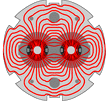
|
LHC
website
The Large Hadron Collider (LHC) is a particle accelerator complex that will collide opposing beams of 7 TeV protons together in order to explore the validity and limitations of the highly successful current theoretical picture for particle physics, the standard model, which is known however to break down at sufficiently high energy. It is being built by the European Organization for Nuclear Research (CERN), and lies under the Franco-Swiss border near Geneva, Switzerland, where it is undergoing commissioning while being cooled down to its final operating temperature of approximately 2K. The first beams are due for injection in August 2008, with the first collisions planned to take place about two months later.
The LHC will become the world's largest and highest-energy particle accelerator. The LHC is being funded and built in collaboration with over two thousand physicists from thirty-four countries as well as hundreds of universities and laboratories.
|
LCLS
–
The Linac Coherent Light Source

|
LCLS
website
The Linac Coherent Light Source (LCLS) which is in development in SLAC (Stanford Linear Accelerator Center), will be the world's first x-ray free electron laser when it becomes operational in 2009.
LCLS is currently in the detailed project engineering and design phase, with a construction start planned in FY2005. Pulses of x-ray laser light from LCLS will be many orders of magnitude brighter and several orders of magnitude shorter than what can be produced by any other x-ray source available now or in the near future. These characteristics will enable frontier new science in areas that include discovering and probing new states of matter, understanding and following chemical reactions and biological processes in real time, imaging chemical and structural properties of materials on the nanoscale, and imaging non-crystalline biological materials at atomic resolution. The LCLS project is funded by the U.S. DOE and is a collaboration of six national laboratories and universities.
|
BB
–
Beta-beam Task
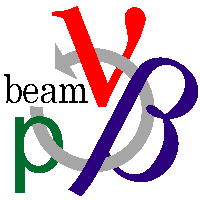
|
BB
website
The acceleration of high intensity, radioactive ion beams to highest energies is a new field for accelerator physics and requires novel design solutions. To date no profound studies on the subject have been made. The objective is to do a Conceptual Design Study (CDS), covering all accelerator physics aspects, to demonstrate the feasibility of a Beta Beam facility. The final report will contain: the optics design of the accelerator chain, beam dynamic simulations of critical processes, a loss management concept, first stage technical designs demonstrating the feasibility of critical hardware, a facility layout and a cost estimate.
The combination of EURISOL with a Beta Beam would make optimum use of the enormous potential synergies and give a world class facility attracting not only the nuclear, but also neutrino and particle physics communities.
|
n_TOF
–
Neutrons Time of Flight
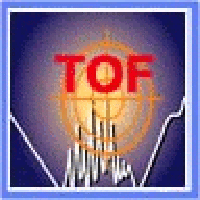
|
n_TOF
website
The main advancement of the state-of-the-art offered by the n_TOF experiment lies exactly in the dissemination of a complete and consistent set of high accuracy cross-sections, extending over eight orders of magnitude in the neutron energy and satisfying the aforementioned demanding research and industrial requirements. Due to the flexible configuration of the CERN accelerator complex and the innovative technological concepts that are exploited within the n_TOF project.
The design of any ADS (Accelerator Driven System) prototype requires the complete and precise knowledge of basic nuclear data in the form of cross sections for neutron induced processes. It might be argued that the presently available databases for this application are just adequate for conceptual studies but it is certainly not accurate enough for the design and simulation of ADS devices. Nuclear data contained in these databases stem from compilations of numerous distinct experiments, which by being inherently dedicated to specific energy domains and elements each time, are often not in perfect agreement or even mutually incompatible. The discrepancies are worse in the case of minor actinides, fission products and the isotopes of the Th cycle, their intrinsic radioactivity being one of the reasons.
|
CNGS
–
CERN Neutrinos to Gran Sasso
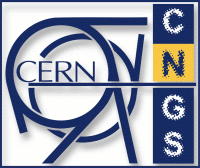
|
CNGS
website 1
CNGS
website 2
The CNGS project aims at investigating the 'oscillation' of neutrinos. The project is motivated by the results obtained at the Superkamiokande detector in Japan and supported by other experiments, observing neutrinos produced by cosmic rays in the atmosphere. These experiments measure a significant deficit in the flux of deteced muon-type neutrinos.
The features of this 'anomaly' could be explained by the hypothesis of neutrino oscillation, i.e. the conversion of a given neutrino type into another during their travel from the source to the detector (for example, muon-type to tau-type neutrino oscillation). The CNGS facility aims at directly detecting such neutrino oscillations and confirming this fascinating hypothesis with artificially produced neutrinos from an accelerator.
A beam produced at the CERN SPS accelerator will consist of only muon-type neutrinos. Neutrinos interact very rarely with matter, and these particles can therefore pass undisturbed underground to their destination, the Gran Sasso National Laboratory (LNGS) of the INFN in Italy, 730 km from CERN. This laboratory located 120 km to the east of Rome, exists since 1987 and many experiments have been conducted there by international collaborations. LNGS is currently preparing to house huge detectors specially designed to detect the rare tau-neutrinos created by "oscillation" from muon-neutrinos on the way between CERN and LNGS.
The CNGS project's mandate is the construction of the new neutrino beam facility at CERN, not including the work needed for the detectors at LNGS. CNGS has been approved by the CERN Council at its December 1999 meeting. Construction started in September 2000, and first beam is expected in May 2006.
|
ICARUS
–
ICARUS Neutrino Oscillation Experiment
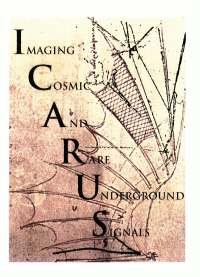
|
ICARUS
website
The main scientific goal is the one of elucidating in a comprehensive way the pattern of neutrino masses and mixings, following both the S-KAM results and the predictions on atmospheric neutrinos of the large solution of the Solar Neutrinos deficit.
Please find more information on this project following the above link. FLUKA will be used as the main physics simulation tool for this experiment.
|
Last updated: 10th of October, 2008
|











